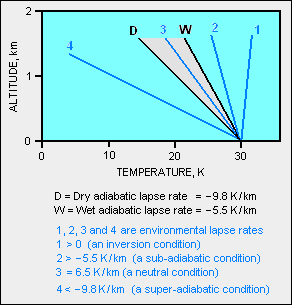User:Milton Beychok/Sandbox
The atmospheric lapse rate ( ) refers to the change of an atmospheric variable with a change of altitude, the variable being temperature unless specified otherwise (such as pressure, density or humidity).[1][2][3] While usually applied to Earth's atmosphere, the concept of lapse rates can be extended to atmospheres (if any) that exist on other planets.
Lapse rates are usually expressed as the amount of temperature change associated with a specified amount of altitude change, such as 9.8 K per kilometre, 0.0098 K per metre or the equivalent 5.4 °F per 1000 feet. If the atmospheric air cools with increasing altitude, the lapse rate may be expressed as a negative number. If the air heats with increasing altitude, the lapse rate may be expressed as a positive number.
The lapse rate is most often denoted by the Greek capital letter Gamma, or Γ,[4] but not always. For example, the U.S. Standard Atmosphere uses L to denote lapse rates:[5] A few others use the Greek lower case letter gamma, , which is an unfortunate choice since gamma is also used for the specific heat ratio.
Types of lapse rates
There are three types of lapse rates that are used to express the rate of temperature change with a change in altitude, namely the dry adiabatic lapse rate, the wet adiabatic lapse rate and the actual ambient lapse rate.
Dry adiabatic lapse rate
Since the atmospheric pressure decreases with altitude (see Earth's atmosphere), the volume of an air parcel expands as it rises. Conversely, if a parcel of air sinks from a higher altitude to a lower altitude, its volume is compressed by the higher pressure at the lower altitude. An adiabatic lapse rate is the rate at which the temperature of an air parcel changes in response to the expansion or compression process associated with a change in altitude, under the assumption that the process is adiabatic (meaning that no heat is added or lost during the process).
Earth's atmospheric air is rarely completely dry. It usually contains some water vapor and when it contains as much water vapor as it is capable of, it is referred to as saturated air (i.e., it has a relative humidity of 100%). The dry adiabatic lapse rate refers to the lapse rate of unsaturated air (i.e., air with a relative humidity of less than 100%). It is also often referred to as the dry adiabat, DALR or unsaturated lapse rate. It should be noted that the word dry in this context simply means that no liquid water (i.e., moisture) is present in the air ... water vapor may be and usually is present.
The dry adiabatic lapse rate can be mathematically expressed as:[6]
| where: | |
| = the dry adiabatic lapse rate, 0.0098 K/m (equivalent to 9.8 K/km) | |
| = Earth's gravitational acceleration, 9.8076 m/s2 | |
| = the specific heat of dry air at constant pressure, 1004.64 J/(kg K) |
The troposphere is the lowest layer of the Earth's atmosphere. Since and vary little with altitude, the dry adiabatic lapse rate is approximately constant in the troposphere.
Wet adiabatic lapse rate
The wet adiabatic lapse rate can be mathematically expressed as:[7]
| where: | |
| = Wet adiabatic lapse rate, K/m | |
| = Earth's gravitational acceleration = 9.8076 m/s2 | |
| = Heat of vaporization of water, J/kg | |
| = The ratio of the mass of water vapor to the mass of dry air, kg/kg | |
| = The universal gas constant = 8,314 J/(kmol K) | |
| = The molecular weight of any specific gas, kg/kmol = 28.964 for dry air and 18.015 for water vapor | |
| = The specific gas constant of a gas, denoted as | |
| = Specific gas constant of dry air = 287 J/(kg K) | |
| = Specific gas constant of water vapor = 462 J/(kg K) | |
| =The dimensionless ratio of the specific gas constant of dry air to the specific gas constant for water vapor = 0.6220 | |
| = Temperature of the saturated air, K | |
| = The specific heat of dry air at constant pressure, J/(kg K) |
Actual ambient lapse rate
Lapse rates and atmospheric stability
References
- ↑ The lapse rate is often defined as the negative change of temperature with a change of altitude. That definition leads to statements such as "A positive lapse rate indicates cooling as height increases while a negative lapse rate indicates warming as height increases". That is counter-intuitive since lapse rates are usually denoted as a negative number (i.e., - 6.5 K/km) to indicate cooling with an increase of height.
- ↑ Lapse rates and air parcels Professor Robert Fovell, Department of Atmospheric and Oceanic Science, University of California, Los Angeles
- ↑ Characteristics of Air Parcels and Air Masses; Clouds Dr. Nicholas Short, National Aeronautics and Space Administration (NASA)
- ↑ is the LaTex rendition and Γ is the HTML rendition.
- ↑ U.S. Standard Atmosphere, 1976
- ↑ John E. Frederick (2008). Principles of Atmospheric Science, 1st Edition. Jones and Bartlett. ISBN 0-7637-4089-6.
- ↑ Glossary of Meteorology The glossary of the American Meteorological Society
Hold items
- Mark Zachary Jacobson (2005). Fundamentals of Atmospheric Modeling, 2nd. Cambridge University Press. ISBN 0-521-83970-X. </ref>
- C. Donald Ahrens (2006). Meteorology Today, 8th. Brooks/Cole Publishing. ISBN 0-495-01162-2. </ref>




















